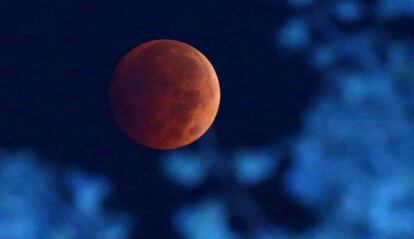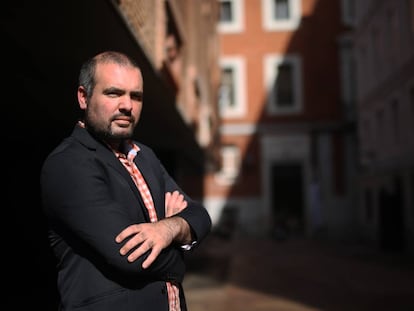Your guide to this century’s longest lunar eclipse
The blood moon on July 27 could provide information about the hole in the ozone layer

The Earth will slip between the sun and the moon on the night of July 27, producing the 21st century’s longest lunar eclipse, which will start at 9.30 pm Spanish mainland time and last for 102 minutes.
During the time it takes the moon to pass through the Earth’s shadow, it will produce a red hue, to which it owes its moniker of ‘blood moon’. But although this is the most arresting aspect of the phenomenon, the eclipse will also help scientists better understand the state of the Earth’s atmosphere, according to Miquel Serra, an astronomer at the Astrophysics Institute in the Canary Islands (IAC).
The intensity of the red hue from the blood moon indicates the state of the Earth’s atmosphere
As the moon enters the Earth’s shadow, one might expect it to become invisible, but this is not in fact the case, as Serra explains. “We see it because the Earth’s atmosphere has two effects on the solar light.”
The first of these is what is known as refraction, which involves a curving of the sun’s rays that surround the Earth as far as the moon. The second is similar to what happens at sunset. The atmosphere scatters the most vibrant wavelengths from the solar light, such as green and blue, leaving only the red rays to reach the moon’s surface. “The result is a moon that is lit up by copper tones and it is spectacular,” says Serra, who finds the phenomenon particularly fascinating because the intensity of the red will indicate the state of the Earth’s atmosphere.
The hue of the blood moon during the eclipse can be linked to pollution in the atmosphere. But more importantly, according to Serra, it can indicate the general state of the atmosphere at a specific moment. The reason for this is that, besides particles of contamination, there are other factors at work such as the presence of clouds and volcanic emissions in certain regions of the planet. “The volcanic particles increase the intensity of the red hue,” says Antonio Pérez, a specialist in astronomy and space science.

The lunar eclipse can also shed light on the state of the hole in the ozone layer, which, according to Serra, appears to be linked to the size of the shadow cast by the Earth. The IAC team will be traveling to Namibia on the 27th where they will be able to watch the phenomenon from start to finish, enabling them to calculate the color of the total eclipse and gather data concerning the size of the lunar shadow, which, as Serra explains, varies every two years from eclipse to eclipse.
The team will also transmit the eclipse live on their website, enabling people from all over the world to see it in all its glory. This will be done in collaboration with Sky.live and will also be available on the EL PAÍS website.
The total eclipse will be visible across Africa, the Middle East and in certain countries in central Asia while Australia will only be able to see the start, and South America the end. In Spain, meanwhile, the beginning of the total eclipse will coincide with the moon coming out in Madrid at 9.30 pm and will remain visible until 11.13 pm. The most spectacular moment will be at 10.22 pm.
The entire phenomenon will last three hours and 55 minutes, taking into account the time the moon moves through the clearest part of the Earth’s shadow.
“It has been more than two years since we have had a total eclipse of the moon visible from Europe, and though it won’t be completely visible from Spain, you will be able to see the tail end of the phenomenon,” says Serra. The only place where the beginning of the eclipse will be visible is the Balearic Islands. The rest of the phases will be visible from Spain’s mainland and from the Canary Islands, but Antonio Pérez does recommend choosing a spot with a clear horizon and using binoculars or a telescope.
The lunar eclipse is just one day from coinciding with the most brilliant night on Mars in recent years, which is July 28. “These are orbital matters for Mars and not linked to the eclipse, but both phenomena are taking place this weekend and they are of great astronomical interest,” says Pérez.
Best places to see the blood moon in Spain
Observatories will be open to the public in various cities across Spain. Madrid’s Planetario will offer free entry and access to a large collection of telescopes while specialized staff will be on hand to help and inform the pubic. The main façade of the building will have the live transmission of the blood moon projected onto it accompanied by an audio providing information on the moon and other astronomical curiosities.
In Barcelona, the go-to spot is the CosmoCaixa Science museum, where instruments and experts will be available.
Meanwhile, Planetario of Aragón will focus on the eclipse for an entire week. And in the gardens of Walqa in Huesca, telescopes and experts will talk the public through the phenomenon.
English version by Heather Galloway.
Tu suscripción se está usando en otro dispositivo
¿Quieres añadir otro usuario a tu suscripción?
Si continúas leyendo en este dispositivo, no se podrá leer en el otro.
FlechaTu suscripción se está usando en otro dispositivo y solo puedes acceder a EL PAÍS desde un dispositivo a la vez.
Si quieres compartir tu cuenta, cambia tu suscripción a la modalidad Premium, así podrás añadir otro usuario. Cada uno accederá con su propia cuenta de email, lo que os permitirá personalizar vuestra experiencia en EL PAÍS.
¿Tienes una suscripción de empresa? Accede aquí para contratar más cuentas.
En el caso de no saber quién está usando tu cuenta, te recomendamos cambiar tu contraseña aquí.
Si decides continuar compartiendo tu cuenta, este mensaje se mostrará en tu dispositivo y en el de la otra persona que está usando tu cuenta de forma indefinida, afectando a tu experiencia de lectura. Puedes consultar aquí los términos y condiciones de la suscripción digital.
More information
Archived In
Últimas noticias
Reinhard Genzel, Nobel laureate in physics: ‘One-minute videos will never give you the truth’
Pinochet’s victims grapple with José Antonio Kast’s rise in Chile
How Japan is trying to avert ‘digital defeat’
The complicated life of Francesca Albanese: A rising figure in Italy but barred from every bank by Trump’s sanctions
Most viewed
- Pablo Escobar’s hippos: A serious environmental problem, 40 years on
- Why we lost the habit of sleeping in two segments and how that changed our sense of time
- Charles Dubouloz, mountaineering star, retires at 36 with a farewell tour inspired by Walter Bonatti
- Trump’s obsession with putting his name on everything is unprecedented in the United States
- The Florida Keys tourist paradise is besieged by immigration agents: ‘We’ve never seen anything like this’









































